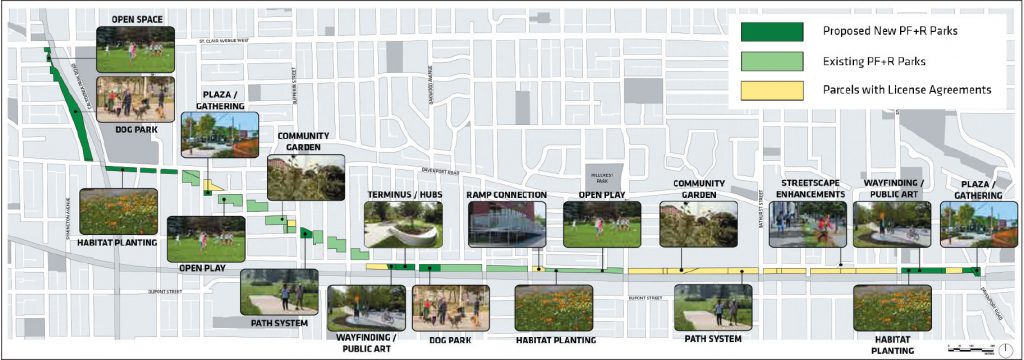Long linked greenspace north of the tracks in the works

By Mary An
Five kilometres of scattered hydro-electric corridor space just north of Dupont Street is set to become a park called the Green Line. According to the Green Line Implementation Plan on the city’s website, this project will connect green space along the corridor to ensure safety, improve walkability, and connect communities.
“The need for the Green Line is clear, and we need it to work for people from all walks of life,” wrote Evan Castel, co-chair of the Davenport Neighbourhood Association (DNA) in an email to the Gleaner. “Some of these [land parcels] are well-used but aging parks, and others are fenced-off hydro lands that are used only informally by folks who step over fallen fences to walk their dogs.”
The park will be made up of forty-five land parcels in total.

Helena Grdadolnik of Workshop Architecture spearheaded the idea in 2012.
Public support for the project grew thanks to partnerships with DNA and Park People, and through events such as community walks, photo exhibits, mural parties, and pollinator gardens. In 2016, the city initiated the Green Line Implementation plan, and Workshop Architecture won the commission for the Green Line Implementation Plan with DTAH and Dillon Consulting. City of Toronto Parks, Forest and Recreation then took the initiative under their wing, and included community input.
The city’s 2019 project plan aims to improve existing land parcels by; licensing new green parcels from both the province and Hydro One, making improvements to the city’s rights-of-way and land adjacent to the parcels, and making road crossings safer for pedestrians. However, the originator of the Green Line idea is sceptical about whether this can actually be accomplished.
“The recent park designs do not meet the original vision because the Green Line is now defined as only the green space under the hydro corridor. This is limited by what Hydro One will grant permission for, rather than integrating it fully with the adjacent street and both sidewalks,” says Grdadolnik. “The street, Geary Avenue, is being rethought by another city department and on a different timeline.”
According to an email from the City of Toronto, after applying to Hydro One for “a secondary use agreement in order to get permission to create parkland,” the city must design the parks to maintain safe clearance around the transmission towers and to ensure that trees planted within the parks follow the height restriction within the wire zone.
By breaking the initiative into 20 smaller projects, the city plans to complete the Green Line within the next 10 years.
As reported by the Gleaner in January, the city has begun the design process for Macpherson Avenue Park, located at Macpherson Avenue and Davenport Road.
It will be the first new park and will act as a gateway to the other green spaces along the Line.
According to the City of Toronto’s website, the construction of this park is expected to begin in 2022.
Along with Macpherson Avenue Park, the city is also moving forward with the Green Line by expanding Geary Avenue Parkette into a full park. Currently the park runs along the south side of Geary Avenue, between Ossington Avenue and Delaware Avenue North.
The city plans to expand the park west along the hydro-electric corridor to Westmoreland Avenue North. They are expected to start construction on this park in 2022 after receiving approvals from the design team and Hydro One. Both parks will include new structures, lots of green space, and place marker designs that speak to the community’s history. The City of Toronto has also released a thorough description about these new additions on their website.
“We hope the Green Line can pull off a balancing act of offering great green space and street design that acknowledges the unique industrial heritage of our rail and industrial lands. We’ve been excited to see these being reinvented as creative employment spaces,” Castel said.
READ MORE ON PARKS AND GREEN SPACES:
- CHATTER: A new green space within the Annex (Jan. 2021)
- FOCUS: A literary trailblazer (Oct. 2020)
- GRADING OUR GREENSPACE: Grading the green (August 2020)
- FORUM: Making it green (Aug. 2020)
- FOCUS: Robert Street Field site of geothermal energy (Mar. 2020)
- CHATTER: Park gets a haircut (Nov. 2019)
- CHATTER: Park still ignored by city (Oct. 2019)
- NEWS: City fails to maintain park (Sept. 2019)
- GRADING OUR GREENSPACE: Park it here (August 2019)
- GRADING OUR GREENSPACE: Open spaces in the heart of the Annex (Summer 2019)
- NEWS: Huron-Washingon Parkette relocates while UTS expands (Spring 2019)
- GRADING OUR GREENSPACE: The best and worst of local parks(Summer 2018)
- GRADING OUR GREENSPACE: More attention to green spaces means parks are improving (July 2018)
- GRADING OUR GREENSPACE: Parks on the fringe (AUGUST 2017)
- GRADING OUR GREENSPACE: Open spaces in the heart of the Annex (July 2017)
- GRADING OUR GREENSPACE: Survey reveals significant upgrades (June 2017)
- GRADING OUR GREENSPACE: Meet our parks supervisor (August 2016)
- Part two of our 2016 parks review (July 2016)
- NEWS: Renewing Margaret Fairley Park (JULY 2016)
- PART ONE: Green sanctuaries in the heart of the city (June 2016)
- Grading our Greenspace (2015)
